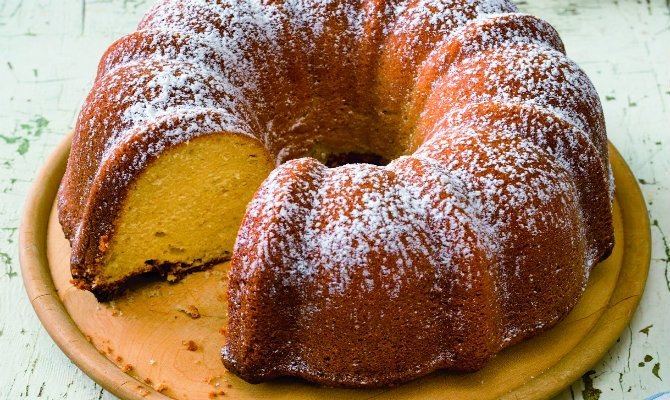Lost-And-Found Lemon Pound Cake
Lost-And-Found Lemon Pound Cake
Back in the late 1970s, my Aunt Laura was working in a nursing home, and one of her patients, Miss Mary Martin, kept talking about her delicious lemon pound cake. When she was finally well enough to leave and go home, Miss Martin took my aunt’s address and promised to send her the recipe.She did, but she was also struggling with the lingering effects of the stroke she’d suffered, and the recipe was so tangled up that Aunt Laura couldn’t figure it out. Years later, when Aunt Laura gave me some family recipes and memorabilia, I found the envelope with the recipe inside.Of course I had to try to make it, and finally I figured it out. There were some surprises with it: eight eggs, for one thing, and no baking powder, and the sugar was all confectioners’ sugar. But there was a direction at the top of the recipe, “Follow step by step,” so I was very careful to do that.And oh, my goodness, what a wonderful cake it is! Feathery-light, rich but not at all heavy, lightly sweet. I’m so grateful to Miss Mary Martin for writing it down, and to Aunt Laura for preserving it. This one is like no other pound cake you’ve ever eaten. Excerpted from A Real Southern Cook in Her Savannah Kitchen, © 2015 by Dora Charles. Reproduced by permission of Houghton Mifflin Harcourt. All rights reserved.
Servings
16
servings

Ingredients
- 1 pound good creamy butter, such as kerrygold, softened
- 1 pound confectioners’ sugar
- 1 cup sour cream
- 2 tablespoon pure vanilla extract
- 1 tablespoon pure lemon extract (optional)
- 3 cup cake flour, such as swan’s down
- 1/2 teaspoon baking soda
- 8 large eggs, separated while cold, then brought to room temperature
- confectioners’ sugar, for dusting
Directions
- Set the oven to 325 degrees F. Spray a heavy 10-inch Bundt pan well with baking spray.
- In a large bowl, with an electric mixer on medium speed, cream the butter until light and fluffy. Slowly add the confectioners’ sugar and beat for several minutes, until the mixture is satiny. Add the sour cream, vanilla, and lemon extract, if using, and mix well. Sift the flour and baking soda three times. Add 1 cup of the flour mixture to the butter and mix in well. Then mix in half the egg yolks. Mix in another cup of flour and the remaining yolks. Add the rest of the flour. Don’t overmix, or the cake will be tough. Scrape down the sides of the bowl and the beaters and do the final mixing by hand.
- In a large bowl, with clean beaters, beat the egg whites to stiff peaks. Gently add the whites to the batter, folding them in with a wooden spoon or a rubber spatula—just barely mix everything together. Scrape the batter evenly into the Bundt pan, rotating the pan as you go and twisting it to level the batter. Rap the pan sharply on the countertop about 30 times, rotating the pan slightly each time, to eliminate any air pockets.
- Bake for 30 minutes. If the cake is getting too brown on top, turn the oven down to 300 degrees, then test again in 15 minutes. The cake is done when the top springs back when lightly touched and a toothpick inserted into the center comes out clean, about 45 minutes to 1 hour in all.
- Cool on a rack for 15 minutes, then run a knife around the rim and center tube and invert the cake onto the rack to cool completely. Transfer the cake to a serving plate or a cake stand. Dust with confectioners’ sugar. The cake will keep for at least a week at room temperature if it’s well wrapped; it also freezes well.